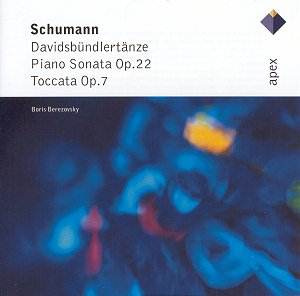What prevented Schumann from pursuing his chosen career
of a pianist was an injury to his hand, self-inflicted apparently in
an attempt to strengthen a finger with a device he himself invented
in 1832. Prior to 1840 his music followed a particular line of poetic
inspiration, with much emphasis on lyrical line to his phrasing and
melodic shape. He had, after all, been brought up literally surrounded
by books as the son of a bookseller, so he was steeped in literature
and poetry far beyond his years. He chose programmatic themes such as
Papillons Op.2 and then Davidsbündlertänze Op.6
(1837), the first piece of music on this disc. This was also the time
of his highly dramatic romance with his future wife, Clara Wieck. ‘As
to what is in the dances’ (Davidsbündlertänze literally
means ‘The League of David’s Dances’), ‘my Clara’, Robert wrote, ‘you
will find that out, for, more than to anything else, they are dedicated
to you. It is a story of an eve-of-the-wedding party and you can imagine
what the beginning and the end looks like. If I was ever happy at the
piano, then it was as I was composing these dances’. The Dances are
dedicated to Goethe’s grandson Walther, and each carries the signature
of one of two names, either Florestan or Eusebius (F or E), whose origins
themselves lie in the identities of twins Vult and Walt in Jean Paul’s
Flegeljahre (‘The Awkward Years’). ‘Two completely new people
make their first appearance in my diary, two of my best friends though
I have never seen them, Florestan and Eusebius’, wrote Schumann in his
diary (June 1831). Bearing in mind the composer’s gradually encroaching
and destabilising mental illness, it comes as no surprise to find these
characters in his diary, and as the embodiment of two distinct personalities,
the gentle Eusebius and the acerbic Florestan. The names also came to
be used as pseudonyms for his writings in his own music periodical,
Neue Zeitschrift für Musik while the title Davidsbündlertänze
was depicted as a group countering Philistinism. The Dances consist
of eighteen short movements or characteristic pieces, all of which carry
indications of mood, such as ‘with humour’, ‘impatiently’, ‘as from
afar’, or ‘tender and singing’, rather than tempo or the more usual
conventional formulaic Italian terms.
Florestan and Eusebius make another appearance in the
second of his two piano sonatas, which largely follow the classic Beethoven
outline and model. He took a few years to complete the work (1833 to
1838) and then, at Clara’s suggestion, substituted a new finale Rondo
(for the original ‘presto passionato’) in which the two characters are
to be found, tempestuous passion in contrast with lyrical pensiveness.
Schumann himself credited Beethoven, John Field, and Czerny with providing
the essential expressive elements of piano writing which influenced
him, richness of part-writing, use of pedal, and volubility. His fingerprint
after the disastrous experiment of 1832 described above subscribes to
these three principles in the textures, arpeggio shapes, handfuls of
notes only playable with the use of the sustaining pedal, and so on.
In the sonata his sense of the dramatic goes into overdrive (‘faster’,
then ‘even faster’ he exhorts his interpreter). Like his contemporary
Mendelssohn, Schumann looked back admiringly to Bach as a model, and
his Toccata (1829-1832) certainly has the stylish virtuosic brilliance,
but also tempered with melodic poetry.
Boris Berezovsky is a natural Schumann player, knowing
just how to pace the ebb and flow of phrasing and mood. His technique
has both translucence of tone and thoughtful control, and he burnishes
the music’s temperament with added lustre and golden sounds in the tradition
of Horowitz or Rubinstein. He achieves some marvellous effects ‘as if
from afar’ in the penultimate Davidsbündlertanz, in particular
sustaining its tension-packed ending, followed by a glorious performance
of the sonata.
This is the ninth and last of a batch of Teldec Apex
CDs sent to me to review, all of which have been of a commendable quality
but sadly, and inexplicably, bereft of any biographical details of the
performers.
Christopher Fifield

![]() Boris Berezovsky, piano
Boris Berezovsky, piano
![]() TELDEC APEX 0927 40834
2 [62.08] Bargain Price
TELDEC APEX 0927 40834
2 [62.08] Bargain Price